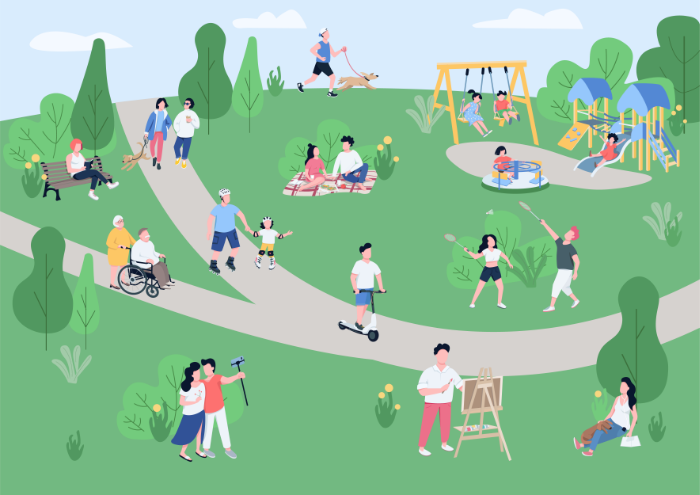A question a lot of new teachers ask is ‘How do you teach the Present Continuous Tense?’. Even seasoned teachers continue to ask themselves how they could add another Present Continuous speaking activity to their grammar lesson. While there is certainly more than one way to skin a cat, in the following post, I’m going to share with you my approach to teaching the Presnt Continuous, and in particualr the speaking activities I use.
Introduction
I start off by asking students what they say when they answer a phone call from a friend. This could be in either English or their own language. Then I give them an example in English which includes ‘Where are you?’ and ‘What are you doing?’ to stress the fact that you can’t see what the other person is doing right now. I give some possible responses like ‘I’m cooking’ or ‘I’m driving’ . I write these answers on the board (or I have them on a powerpoint).
Next I highlight the structure: subject plus verb be plus Verb-ing. I write this on the board clearly, and add some examples below throughout the next part of the lesson.

Controlled practice
For controlled practice, I use a flashcard approach, but instead of cards I have pictures of people doing activities on powerpoint slides. In turn I ask the students ‘What is he doing?’ or ‘What are they doing?’. I will go through about 15 – 30 example like this (depending on class size), with the subject changing from I to He or She to They. I’ll do the same for negative sentences and questions.
Book work or worksheets
Depending on you teaching goals, at this point you may want to get students doing simple grammar exercises either in their course book or on a worksheet. If you are not chained to a coursebook, but need a suitable worksheet – we have a FREE worksheet available HERE.
Present Continuous Speaking Activities
If your class is more speaking focused, you may wish to move straight on to the speaking activities, and save the worksheet for homework / self-study. The choice of activities below will depend somewhat on the levels and abilities of my students.
What Are the Neighbors Doing?
My first speaking activity is often a pair speaking activity. For teaching the Present Continuous, I use an activity called ‘What Are the Neighbors Doing?’. It is essentially a ‘Find the Difference’ activity, but students must solve it in pairs by using only English. I get students to sit facing each other, so they can’t look at their partner’s sheet. The vocabulary is similar to that in the previous powerpoint slides for the controlled practice.
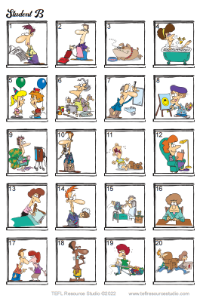
I use this activity with stronger Beginner level classes and Elementary classes.
Present Continuous Board Game
For low beginner classes, I go straight to the Present Continuous Board Game for some more controlled practice with easier vocabulary.
Students roll the dice and move to a square with a picture prompt. They then roll the dice again. If they roll a 1 or 2, they must make an affirmative sentence using the picture prompt. However, if they roll a 3 or 4, they must make a negative sentence. If they roll a 5 or 6, they must ask a question.
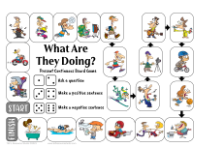
Pair Practice
For beginner levels, I follow up with another pair activity. This is a pair gap fill activity to practice asking closed questions, and switch between ‘Is he/she…?’ and ‘Are they…?’.
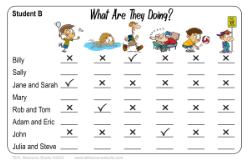
Students have only half of the information on their sheet, so they must ask questions to their partner who has the other half of the information.
Find someone who…? Present Continuous speaking activity
Next, I do a class mingle activity. Students must mingle around the class asking questions such as ‘Are you feeling happy today?’. If another student says ‘Yes’ then they ask their name, and if they can, try and ask as question to find out more information. Students always enjoy class mingle activities, and it’s always good to get them up out of their seats and moving around.
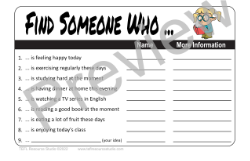
The Final Present Continuous Speaking Activity
Charades
Charades is a very common response to the question ‘What speaking activities can I use to practice the Present Continuous?’. I’ve used charades many times over the years, however, I have found it hit or miss. Charades can go down very well with a class of outgoing students, but more introverted students don’t like to come to the front of the class, and it can be a painful experience if a significant number of students are shy and the class as a whole don’t get into it. For this reason, I no longer include it in my lesson plans. However, you could always do all the actions yourself.
How Good Is Your Memory?
The activity I finish off with I call ‘How Good Is Your Memory’. I have a picture with lots of people doing different activities on it. The picture is labelled with their names. I get the students into groups, and tell them you are going to test their (visual) memory. I tell them I will give them just one minute to remember what is happening in the picture. Then I show them the picture for 1 minute, and they have to remember what they see. Oh, and they can’t take notes, or take a photo during that minute! After the minute is up, I switch to a slide with just the names from the picture. I then ask the groups to write sentences (in English) about what each person was doing in the picture. The group with the most correct sentences wins.
Due to copyright I can’t post the picture I usually use, however, I’ve added a similar image to a powerpoint here: How Good Is Your Memory FREE PPT.
Where to Find These Resources
You can find the resources I’ve created on my TPT store:
‘What Are the Neighbors Doing?’
‘Present Continuous Closed Question Pair Speaking Activity’
‘Present Continuous Board Game’
All the above are also available in the ‘Present Continuous Speaking Activity Bundle’ with a discount.
Charades activities are rather ubiquitous, however, if you are unable to find an activity you like, leave a comment below.
That’s All Folks!
As we said in the beginning, there is more than one way to skin a cat. Do you do things differently? Did we miss your favorite go-to activity for pracising the Present Continuous Tense? Why not let us kno in the coments below?
If you’d like to stay up to date with new ideas and resources for your ESL language classroom, why not sign up to our mailing list?

